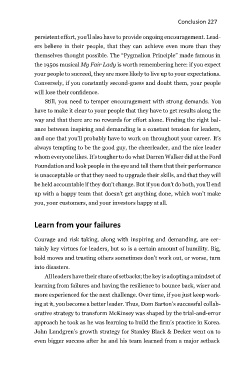Page 238 - HBR Leader's Handbook: Make an Impact, Inspire Your Organization, and Get to the Next Level
P. 238
Conclusion 227
persistent effort, you’ll also have to provide ongoing encouragement. Lead-
ers believe in their people, that they can achieve even more than they
themselves thought possible. The “Pygmalion Principle” made famous in
the 1950s musical My Fair Lady is worth remembering here: if you expect
your people to succeed, they are more likely to live up to your expectations.
Conversely, if you constantly second-guess and doubt them, your people
will lose their confidence.
Still, you need to temper encouragement with strong demands. You
have to make it clear to your people that they have to get results along the
way and that there are no rewards for effort alone. Finding the right bal-
ance between inspiring and demanding is a constant tension for leaders,
and one that you’ll probably have to work on throughout your career. It’s
always tempting to be the good guy, the cheerleader, and the nice leader
whom everyone likes. It’s tougher to do what Darren Walker did at the Ford
Foundation and look people in the eye and tell them that their performance
is unacceptable or that they need to upgrade their skills, and that they will
be held accountable if they don’t change. But if you don’t do both, you’ll end
up with a happy team that doesn’t get anything done, which won’t make
you, your customers, and your investors happy at all.
Learn from your failures
Courage and risk taking, along with inspiring and demanding, are cer-
tainly key virtues for leaders, but so is a certain amount of humility. Big,
bold moves and trusting others sometimes don’t work out, or worse, turn
into disasters.
All leaders have their share of setbacks; the key is adopting a mindset of
learning from failures and having the resilience to bounce back, wiser and
more experienced for the next challenge. Over time, if you just keep work-
ing at it, you become a better leader. Thus, Dom Barton’s successful collab-
orative strategy to transform McKinsey was shaped by the trial-and-error
approach he took as he was learning to build the firm’s practice in Korea.
John Lundgren’s growth strategy for Stanley Black & Decker went on to
even bigger success after he and his team learned from a major setback

